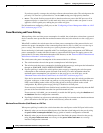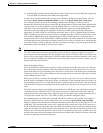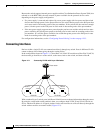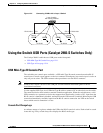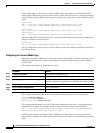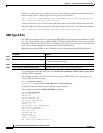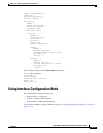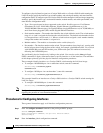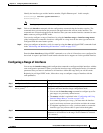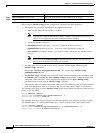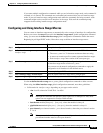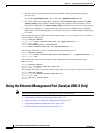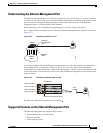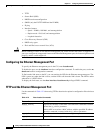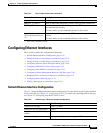
12-16
Catalyst 2960 and 2960-S Switch Software Configuration Guide
OL-8603-09
Chapter 12 Configuring Interface Characteristics
Using Interface Configuration Mode
To configure a physical interface (port) on a Catalyst 2960 switch or a Catalyst 2960-S switch running the
LAN Lite image, specify the interface type, module number, and switch port number, and enter interface
configuration mode. To configure a port on a Catalyst 2960-S switch running the LAN base image (supporting
stacking), specify the interface type, stack member number, module number, and switch port number, and
enter interface configuration mode.
• Type—Port types depend on those supported on the switch. Possible types are: Fast Ethernet
(fastethernet or fa) for 10/100 Mb/s Ethernet, Gigabit Ethernet (gigabitethernet or gi) for
10/100/1000 Mb/s Ethernet ports, 10-Gigabit Ethernet (tengigabitethernet or te) for 10,000 Mb/s, or
small form-factor pluggable (SFP) module Gigabit Ethernet interfaces.
• Stack member number—The number that identifies the switch within the stack. The switch number
range is 1 to 4 and is assigned the first time the switch initializes. The default switch number, before
it is integrated into a switch stack, is 1. When a switch has been assigned a stack member number,
it keeps that number until another is assigned to it.
• Module number—The module or slot number on the switch (always 0).
• Port number—The interface number on the switch. The port numbers always begin at 1, starting with
the far left port when facing the front of the switch, for example, gigabitethernet1/0/1. For a switch
with 10/100/1000 ports and SFP module ports, SFP module ports are numbered consecutively
following the 10/100/1000 ports.
You can identify physical interfaces by looking at the switch. You can also use the show privileged
EXEC commands to display information about a specific interface or all the interfaces. The remainder
of this chapter primarily provides physical interface configuration procedures.
These examples identify interfaces on a Catalyst 2960-S switch running the LAN base image:
• To configure 10/100/1000 port 4 on a standalone switch, enter this command:
Switch(config)# interface gigabit
tethernet1/0/4
• To configure 10/100 port 4 on stack member 3, enter this command:
Switch(config)# interface gigabitethernet3/0/4
This example identifies an interface on a Catalyst 2960 switch or a Catalyst 2960-S switch running the
LAN Lite image:
• To configure 10/100/1000 port 4, enter this command:
Switch(config)# interface gigabitethernet0/4
Note Configuration examples and outputs in this book might not be specific to your switch, particularly
regarding the presence of a stack member number.
Procedures for Configuring Interfaces
These general instructions apply to all interface configuration processes.
Step 1 Enter the configure terminal command at the privileged EXEC prompt:
Switch# configure terminal
Enter configuration commands, one per line. End with CNTL/Z.
Switch(config)#
Step 2 Enter the interface global configuration command.



